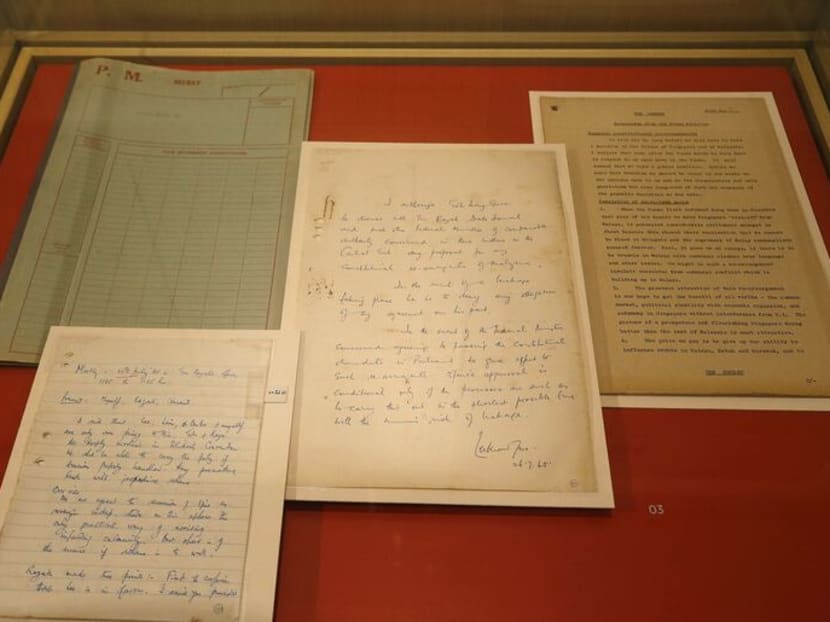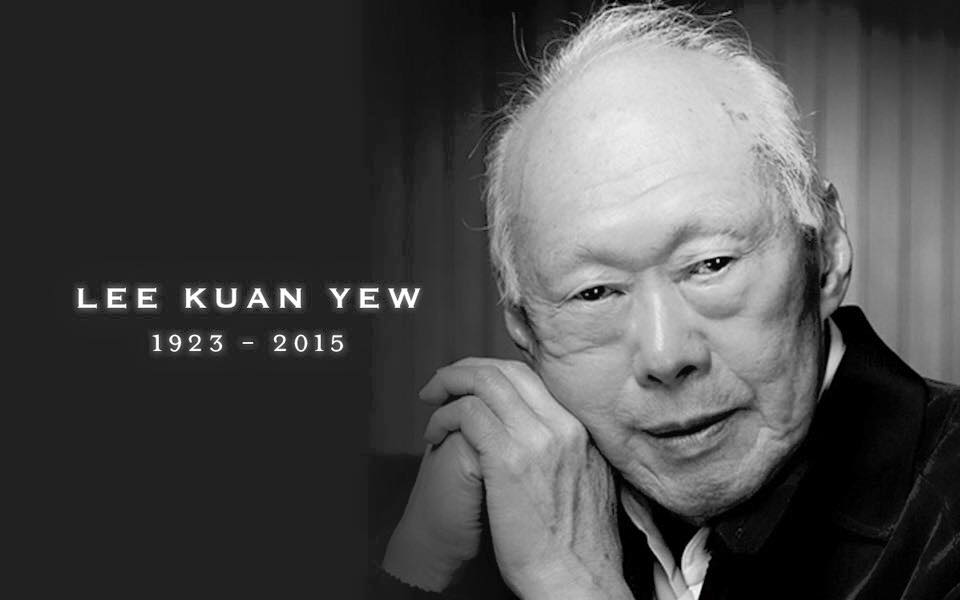Commentary: What the release of Goh Keng Swee’s Albatross File means for Singaporeans

Parts of the Albatross file on display at a special exhibition at the National Museum of Singapore in 2015.
Our past has an impact on our present and also future. As Singaporeans, we should be open to enhancing our understanding of our national history.
On Feb 28, it was reported the Government has agreed to declassify and release documents in Dr Goh Keng Swee’s “Albatross File”, along with specific cabinet papers and Dr Goh’s notes of his conversations with the Malaysian leaders.
In July 1965, Dr Goh was the minister who negotiated the separation of Singapore from Malaysia, and the Albatross File contains details of the discussions.
On Aug 9, 2022, TODAY published a commentary by this author that examined the roles of our founding fathers such as Mr Lee Kuan Yew and Dr Goh in the independence and success of Singapore. The commentary revealed excerpts from a previously confidential document entitled “Memorandum from the Prime Minister”.
In January 1965, Mr Lee examined the possibilities of constitutional rearrangements and noted in the cabinet memo that the “greatest attraction of this rearrangement is our hope to get the benefits of all worlds — the common market, political stability with economic expansion, and autonomy in Singapore without interference from KL”, referring to Kuala Lumpur, capital of Malaysia.
Mr Lee also had an optimistic vision, which he shared with his cabinet ministers: “The picture of a prosperous and flourishing Singapore doing better than the rest of Malaysia is most attractive.”
ALBATROSS FIRST REVEALED IN 1996
Dr Goh’s public revelations of the Albatross File and the negotiations were first published in 1996 in a book entitled Leaders of Singapore by Dr Melanie Chew.In this transcribed interview, Dr Goh said, “Now I’m going to let you into what has been a state secret up to now. This is a file which I call Albatross.” Dr Goh recalled, “Now on the 20th of July 1965, I met Tun Razak and Dr Ismail. Now this is the 20th July 1965. I persuaded him that the only way out was for Singapore to secede, completely.”
Dr Goh said to the Malaysian ministers: “You want to get Singapore out, and it must be done very quickly. And very quietly, and presented as a fait accompli.”
To Dr Chew’s question about the reactions of Tun Razak and Dr Ismail, Dr Goh answered, “Oh, they themselves were in agreement with the idea. In fact, they had themselves come to the conclusion that Singapore must get out. The question was, how to get Singapore out.”
While examining historical records, it is also important to analyse what was actually done.
In July 1965, Mr Lee also asked Law Minister Eddie Barker to draft the separation documents. Mr Lee stated in his memoirs, published in 1998: “Eddie drafted the two documents, but I asked him to draw up a third, a proclamation of independence.”
With the support of Dr Goh and Mr Barker, Mr Lee was making the preparations for what was going to happen in the later part of July and August 1965, leading to our independence.
Mr Lee wanted the water agreement with the state of Johor to be included in the documents and be “endorsed by the two governments as a formal treaty to be honoured as such”.
Mr Lee asked his wife Mrs Lee, who was a capable conveyancing lawyer, to assist with this process. After Mr Lee approved of the drafts, Mr Barker passed them to the Malaysian minister, Tun Razak, who was deeply involved with Dr Goh in the negotiation process.
Tun Razak kept Malaysian Prime Minister Tunku Abdul Rahman updated about these negotiations. Tunku supported and agreed to the separation.
In Tunku Abdul Rahman’s speech presenting the Bill amending the Constitution of Malaysia and the Malaysia Act to the House of Representatives on 9th August 1965, he said: “The separation will be made on the understanding that we shall co-operate closely on matters of defence, trade and commerce.
“This matter was discussed with the Government of Singapore, as a result of which we have drawn up an Agreement which sets out the terms agreed upon and contains those matters which I mentioned just now. This Agreement has been signed by selected members of the Central Government and those of the State Government of Singapore.”
MORE ACCESS TO INFORMATION
In August 1965 when Singapore’s separation was announced, The Straits Times published an article with a photo of then Malaysian Prime Minister Tunku Abdul Rahman and the subheader “Tengku: It was my idea…”This could have given readers and Singaporeans over the decades the impression that Tunku initiated the separation.
In reality, both Tunku and Dr Goh had the idea of separation, and it was Dr Goh who initiated the discussions with Tun Razak and Dr Ismail. And Dr Goh proposed for Singapore to secede completely, while Tunku was recuperating in London in July 1965.
Representations by the media influence public perceptions and narratives. At times, certain narratives might also be relevant for specific periods, given the context at that point in time and limited access to primary sources and alternative accounts.
With the declassification of documents in Albatross File and cabinet papers, Singaporeans will have access to more information revealing that the separation of Singapore from Malaysia was actually a negotiated process, unlike the earlier perceptions that Singapore was simply booted or kicked out.
Since 2015, I have written opinion-editorials and commentaries about the actual nature of our separation. In 2015, extracts of the Albatross File and cabinet papers were made available in the National Museum for a temporary exhibition.
THE PAST TO GUIDE THE FUTURE
The declassification of these documents and its availability to researchers and the public will enable Singaporeans to have a better understanding of our history, specifically our separation and independence.The availability of primary sources, such as cabinet papers and oral history records, will provide us with additional avenues to clearer and more nuanced understanding, which will enable us to have a better comprehension and appreciation of our past, as well the leaders and people involved in our history.
We can also learn from these historical events and apply the learning points to our present and future activities.
At the same time, it may be unsettling for certain individuals, who cling on to the earlier historical views, but it will be useful for them to be receptive to the available evidence, declassified documents and various valid perspectives.
History is not inscribed in stone and with the availability of relevant evidence and primary sources, the writing of history and our understanding should be updated and enhanced. Over the years, our history textbooks have been revised, as described in this commentary.
In the process of researching and writing about our history, there should be verification and triangulation of primary sources.
For instance, the oral history records of Mr Eddie Barker and Dr Goh, along with the memoirs of Mr Lee and Dr Ismail revealed that the separation was successfully negotiated. In Mr Barker’s oral history interview, he identified Dr Goh as the “architect of the separation”.
Mr Barker explained: “We were determined to get out. I think they were just as determined that we should go. It was not a question of them kicking us out, it was an agreement to separate.”
When Mr Barker gave the signed separation documents to Mr Lee, Mr Lee responded: “Thanks Eddie, we have pulled off a bloodless coup.”
Dr Ismail also noted that “the separation of Singapore from Malaysia was by mutual agreement”.
Let us continue to learn and appreciate our history, as well as to make good use of our historical understanding and the useful learning points from our past.
Singapore and Malaysia managed to emerge safely and successfully from this eventful period in our history due to the good relations, mutual understanding, positive intentions and collaboration of our leaders.
It is commendable that this generation of leaders from Singapore and Malaysia also continue to work on their relationships and develop the collaborations between both countries.
Though Singapore and Malaysia have separated, both countries remain close and cordial neighbours. As we deepen our understanding of the past, we should continue to cherish both the past and present, while working for an even better future ahead.
ABOUT THE AUTHOR:
Edmund Lim is a Singaporean executive director at an international cybersecurity education company. He once taught history and social studies at the National Institute of Education, Nanyang Technological University.



